Table of Contents
If you have already experienced back pain, you will probably agree with us that it can make your life very uncomfortable. Then every movement feels like a torture. But what if there is a way to help yourself with back pain? Give these special exercises a chance to relax your back muscles and spine. You need nothing more than an exercise mat and a small amount of time. You will finish in a couple of minutes, which is definitely worth the back pain relief.
Why does your back hurt?
In some cases, the cause of back pain is immediately evident. For example, if you suspect that you overdid it a bit in weight training and didn’t pay attention to the correct technique. Your body then pays you back in the form of back pain in the following days. Or maybe you’ve been sitting and lying in books all weekend learning for the exam in various positions that don’t just resemble healthy posture. However, most often, the back pain is the result of an overload of the musculoskeletal system at work. Many workers working in warehouses, on construction sites or hairdressers, and waiters who are on their feet all the time can confirm this point. [1–5]
Poor posture is one of the most common causes of back pain in the modern world. We spend a lot of time sitting and lying in not exactly ideal positions. That can then affect the sore and stiff back. The most common bad habit is tilting the head, hunching the back or pulling the shoulders forward. It can lead to muscle imbalances, such as upper and lower cross syndrome. These manifest by one muscle taking over the function of the other. A common phenomenon is overloading and shortening of the pectoral muscles, manifested by pulling the shoulders forward and hunching the upper part of the spine. These irregularities often lead to back pain and long-term damage to the spine. At the same time, it is enough to pay attention to the correct posture and do stretching and strengthening exercises that can prevent these imbalances every day or every other day. [1–5]

Other causes of back pain include long-term stress, during which posture usually changes (pulling shoulders forward, hunching the back), muscle tension increases and sleep problems also occur. All this can then result in higher stiffness and back muscle pain.
We cannot forget the negative impact of being overweight, which represents an excessive burden on the entire musculoskeletal system. Wearing high heels, carrying a heavy handbag or sleeping on an unsuitable mattress is not ideal for back health. In some cases, a more severe problem, such as a certain disease, can also cause back pain. If you feel that the pain won’t relieve or, on the contrary, worsens and disrupts your daily activities, it is better to entrust yourself to the care of a specialist. An orthopedist will comprehensively examine you and then suggest a suitable treatment. [1–5]
How to prevent back pain?
Once you know the most common causes of back pain, it’s not that hard to guess how to prevent them. First of all, aim towards the general rules that are part of the principles of a healthy lifestyle. [6–7]
- Focus on good posture. In particular, make sure that you do not bend too much in the thoracic and lumbar spine when standing, sitting, or walking. Keep your head in line with the cervical spine and pull your shoulders slightly back and down.
- Do sports regularly. Engage in physical activities of your choice, at least 150 minutes a week.
- Include strength training at least twice a week, and don’t forget to strengthen the deep stabilization system of the spine, which you may know as the core.
- Use exercises to stretch your back after a long time spent sitting or lying down. You can also try using foam roller exercises or a massage gun.
- If you need to lose weight, start with small changes in your menu, such as eliminating sweets and highly processed foods. Focus on a healthy diet and exercise. It will help you achieve a caloric deficit, being crucial for weight loss.
- Take care of your mental health. Find techniques to help you manage stress better. These include sports, meditation or spending time in nature.
- Limit the wearing of high-heeled shoes and choose comfort in the form of stylish sneakers instead.
- Ideally, exchange a heavy handbag for an elegant backpack. Your back will thank you.
- Get yourself a high-quality mattress for better sleep.
You might be interested in these products:
20 Exercises for Relieving Back Pain
These stretching exercises are ideal for morning stretching, an active break during the working day, or stretching before or after your workout. They will also help you relax your whole body after a physically and mentally demanding day. Try all 20 exercises, or choose just a few of them to create your new stretching routine. The advantage is that you do not need any special equipment. Just unfold the exercise mat, and you’re ready to go.
1. Pelvic Tilt
- Starting position: Lie on your back and bend your knees. The back is in a neutral position relaxed, and the arms are behind the head or extended alongside the body.
- Performance: Tuck your pelvis by controlled movement while exhaling. You can stay in this position for a few seconds or immediately move on to the next rep while inhaling.
- Common mistakes: Pelvis is too high in the upper position, jerky and uncontrolled movements.

2. Glute Bridge
- Starting position: Lie on your back and bend your knees. The feet and palms are on the floor, creating strong support with the upper back.
- Performance: Activate your glutes and core while exhaling. Start raising your pelvis and back slowly by controlled movement. You will get to the position in which your body is in line from the shoulders to the knees. Stay in this position for a few seconds and return to the starting position while inhaling. Then move on to the next rep.
- Common mistakes: Jerky and uncontrolled movement, bent back, a small range of motion.
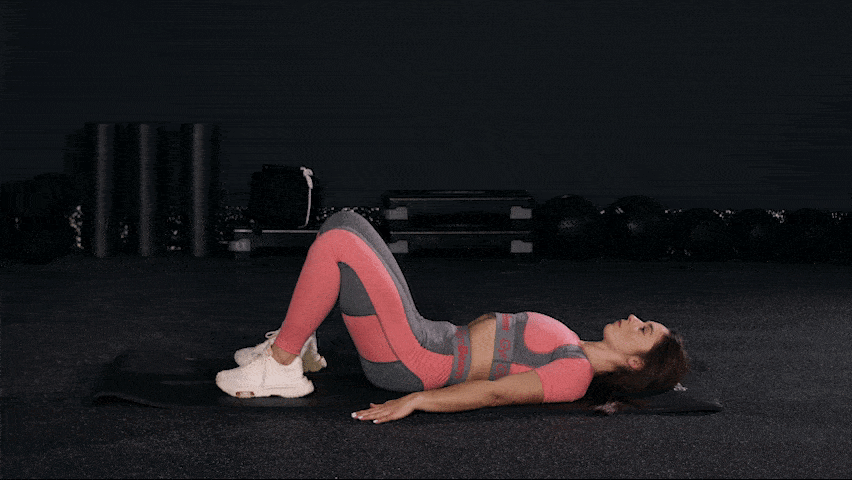
3. Seated Side Bend
- Starting position: Sit down. Bend your knees and cross your legs (so-called crossed-leg sit). The back is curved naturally, and the arms are in line with the body.
- Performance: Put the forearm of your left arm on the mat next to your body. Extend your right arm over your head while exhaling, and simultaneously lean to the same side with the whole torso. You should feel a stretch on the right side of your back. Stay in this position for a few seconds and return to the starting position while inhaling. Then move on to the next rep.
- Common mistakes: Small range of motion, jerky and uncontrolled movements.
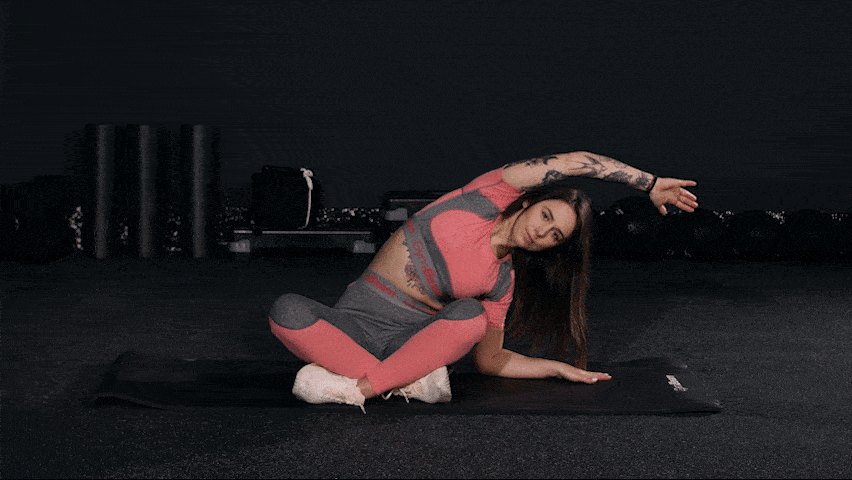
4. Diagonal Seated Side Bend
- Starting position: Sit down. Bend your knees and cross your legs (so-called crossed-leg sit). The back is curved naturally, and the arms are in line with the body.
- Performance: Put your left hand on the knee of your right leg. Raise your right arm upwards and extend it over your head to the side to feel the stretch on the right side of your back. Lean your head and torso slightly to the side as well. Stay in this position for a few seconds, and return to the starting position while inhaling. Then do the same to the other side.
- Common mistakes: Small range of motion, jerky and uncontrolled movements.
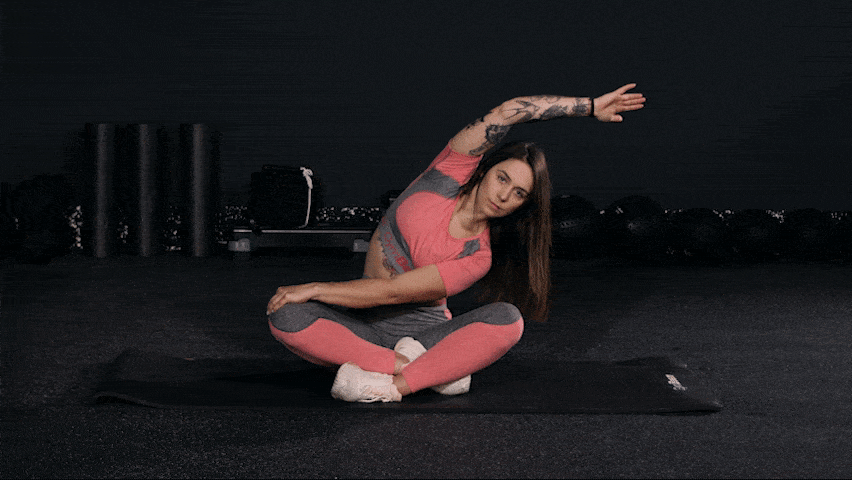
5. Knee to Chest
- Starting position: Lie on your back and bend your knees.
- Performance: Pull your right knee towards the chest. Keep your back on the mat during the whole exercise. Stay in this position for a few seconds while breathing naturally. You should feel the stretch in the lower back. Return to the starting position while inhaling. Then do the same on the other side.
- Common mistakes: Small range of motion, jerky and uncontrolled movement, bent back.
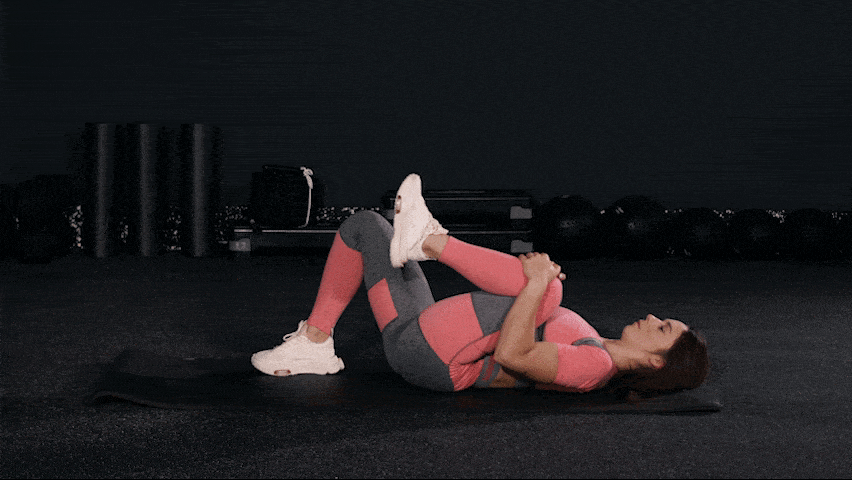
6. Knee Hug
- Starting position: Lie on your back and bend your knees.
- Performance: Pull your both knees towards the chest while exhaling. You can slightly raise your lower back off the mat during this stage. In this position, try to breathe naturally, and you can even lightly swing to the sides and perform this for a few seconds. Return to the starting position while inhaling and repeat the exercise a couple of times.
- Common mistakes: Small or excessive range of motion, jerky and uncontrolled movements.
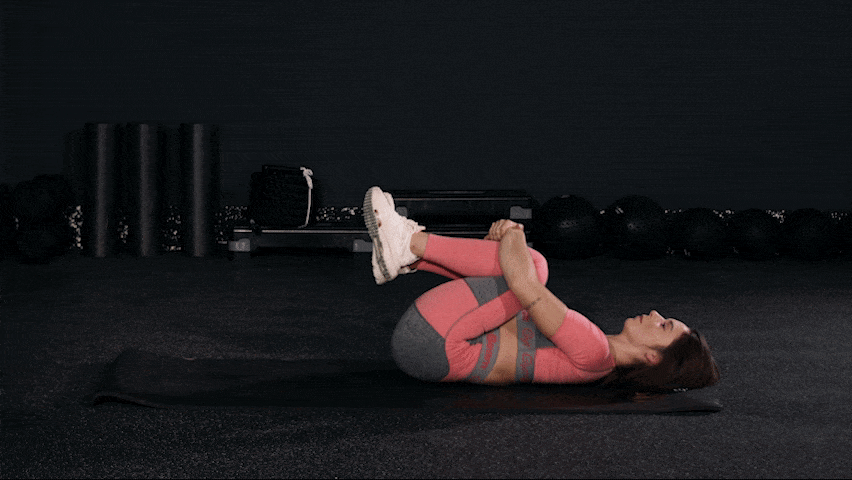
7. Cobra Pose
- Starting position: Lie on your stomach with your legs extended. Place your palms at shoulder level and keep your elbows close to your body.
- Performance: Press your palms to the mat while inhaling and raise the upper chest. The pelvis stays on the mat. Stay a few seconds in the upper position, breathe naturally and return to the starting position while exhaling. Then repeat the exercise a couple of times.
- Common mistakes: Small or excessive range of motion, jerky and uncontrolled movement, raising the pelvis from the mat.

8. Downward Dog
- Starting position: Get down on all fours.
- Performance: Shift your weight to the upper limbs while inhaling, push the palms to the mat and raise your hips towards the ceiling. At the same time, stretch your arms and legs. The knees can be slightly bent. The head remains in line with the spine, and the back is straight. Stay a few seconds in the upper position, breathe naturally. Then return to the starting position while exhaling. Then repeat the exercise a couple of times.
- Common mistakes: Small range of motion, jerky and uncontrolled movements, bent back.
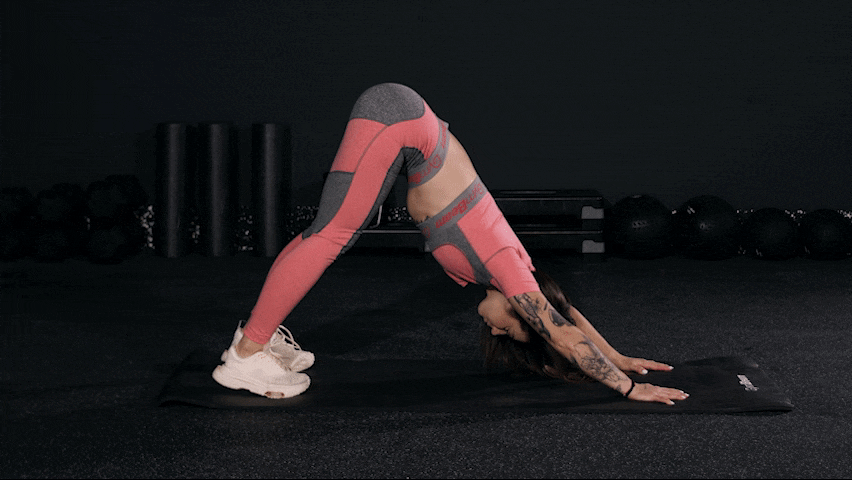
9. Child’s Pose
- Starting position: Get down on all fours. Keep your knees at a distance of about shoulder-width or slightly wider.
- Performance: Push the palms to the mat and slowly sit on your heels. Keep your hands straight and loose in front of you. Rest your forehead on the floor and loosen up your body. Tuck your belly in slightly. Stay in this position for a few seconds, breathe naturally and return to the starting position while exhaling. Then repeat the exercise a couple of times.
- Common mistakes: Small range of motion, bent elbows.
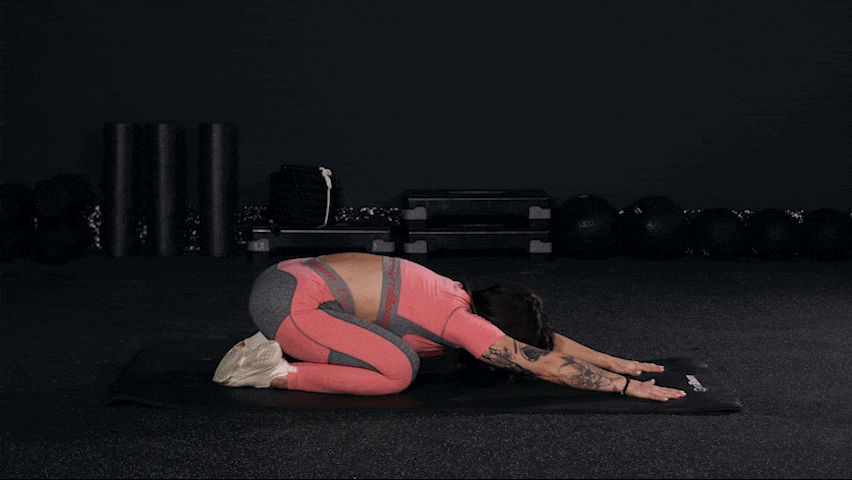
10. Puppy Pose
- Starting position: Get down on all fours. Keep your knees at a distance of about shoulder-width or slightly wider.
- Performance: Extend your arms in front of you and place your forehead on the mat. Keep your knees under your hips and tuck the belly in slightly. Stay in this position for a few minutes, breathe naturally and return to the starting position while exhaling. Then repeat the exercise a couple of times.
- Common mistakes: Small range of motion, bent elbows.
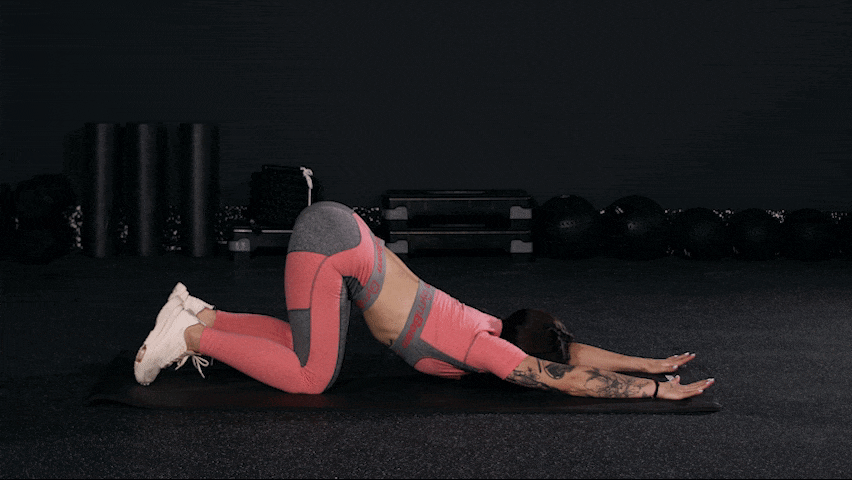
11. Cat Cow Pose
- Starting position: Get down on all fours. Keep your wrists under your shoulders and the knees at about a shoulder-width distance or slightly wider.
- Performance: Bend your head forward towards the chest and round your back upwards. Tuck in your pelvis and belly. Raise your head and bend your back downwards while inhaling (the belly is closer to the mat). Then repeat this movement a couple of times.
- Common mistakes: Small range of motion, uncontrolled movements.
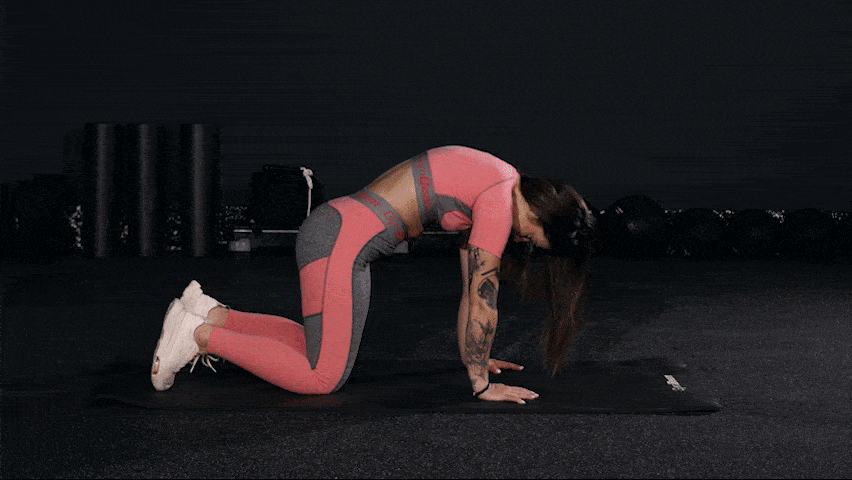
12. Seated Spinal Twist
- Starting position: Sit down to your mat with your legs extended in front of you.
- Performance: Bend your right leg and place it over your left leg, which stays stretched. Place your left elbow over your right knee and slightly lean against it. At the same time, turn to the side with your whole torso. Leave your right arm behind your body and use it as a support point. Stay in this position for a few seconds and breathe naturally. Then return to the starting position, switch legs, and do the exercise on the other side.
- Common mistakes: Small range of motion, uncontrolled movements.

13. Supine Spinal Twist
- Starting position: Lie on your back with your legs extended.
- Performance: Bend your left leg (approx. 90 °) and place it over your right leg, which stays extended. Raise your arm and place it next to your body. Place your right arm on the left knee and slightly lean against it. Remember to point your head and chest upwards (the thoracic and cervical spine is close to the mat) and prevent them from turning to the sides. You can achieve it by leaving your bent leg in the air. Stay in this position for a few seconds and breathe naturally. Then return to the starting position, change legs, and do the exercise on the other side.
- Common mistakes: Small range of motion, turning the head and chest to the sides, uncontrolled movement.
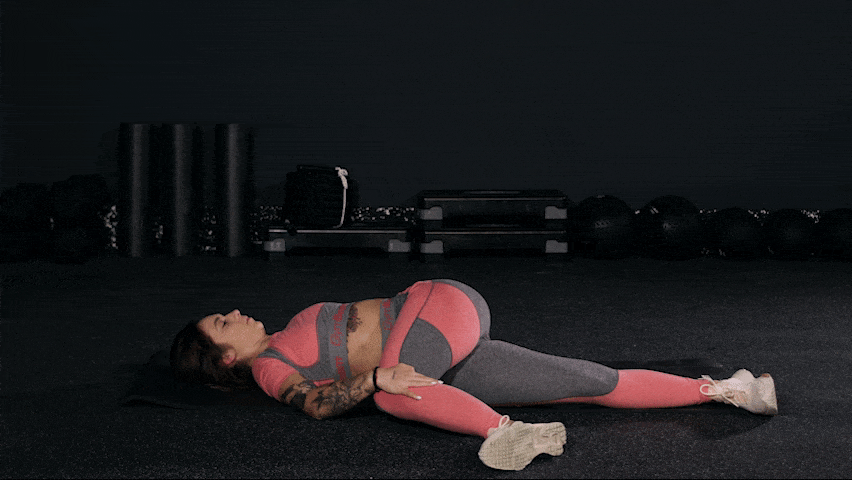
14. Bird Dog
- Starting position: Get down on all fours.
- Performance: Activate your core and simultaneously raise and stretch the opposite limbs while inhaling (the right leg and the left arm). Then bend the raised limbs and pull them towards your chest. Try to touch your knee with your elbow. Then repeat the exercise a couple of times. Then switch the leg and arm and do the same on the other side. If you struggle with balance, remain in the first phase – extending the opposite limbs.
- Common mistakes: Bent back in the first phase, uncontrolled movement, a small range of motion.

15. Prone Press Up
- Starting position: Lie on your stomach. Keep your legs extended. Raise and bend your arms (approx. 45° at the elbows) and place your palms with your fingers open on the floor facing one another.
- Performance: Raise your head, shoulders, and upper chest off the mat while inhaling. Keep the forearms and palms on the mat. Return to the starting position while exhaling and repeat the exercise. Remember to raise your head up, as opposed to tilting it back.
- Common mistakes: Uncontrolled movement, tilting the head back.

16. Kneeling T-Spine Rotation
- Starting position: Get down on all fours.
- Performance: Hold your with your right hand (behind the ear), and do the chest rotation to the right side while exhaling. Return to the starting position while inhaling and repeat the exercise a couple of times. Then switch hands and do the rotation to the other side.
- Common mistakes: Uncontrolled movement, a small range of motion, pressing the hand to the head excessively.

17. Alternate Scorpion Rotations
- Starting position: Lie on your stomach and extend your arms sideways.
- Performance: Raise your left leg, bend it and drag it over your right leg while exhaling. Try to get to the position where you touch the floor or where your mobility allows without raising the arms and chest too much off the floor. At the same time, turn your head to the opposite side. Then return to the starting position while inhaling, raise your right leg and repeat the exercise to the other side.
- Common mistakes: Uncontrolled movement, a small range of motion, raising arms and torso off the mat excessively.

18. Threading the Needle
- Starting position: Get down on all fours.
- Performance: Raise your left arm towards the ceiling while inhaling and rotate your chest and head in the same direction. Then put your left arm through the gap under your right arm and rotate your torso in the same direction. At the same time, place your head on the mat (touching it with your ear). Your eyes should be facing the working arm. Also, remember to move your upper body only. Repeat the exercise a couple of times on one side, then switch your arms.
- Common mistakes: Uncontrolled movement, a small range of motion.

19. Bent-Over T-Spine Rotation
- Starting position: Shoulder-width stance (or slightly wider).
- Performance: Bend your knees and lean forward deeply with your back straight. At the same time, place your palms or fingers on the mat. Raise one arm towards the ceiling while inhaling, and turn your torso and head in the same direction. Your eyes are facing your working arm. Then return to the starting position while inhaling and rotate to the other side.
- Common mistakes: Uncontrolled movement, a small range of motion, bent back.
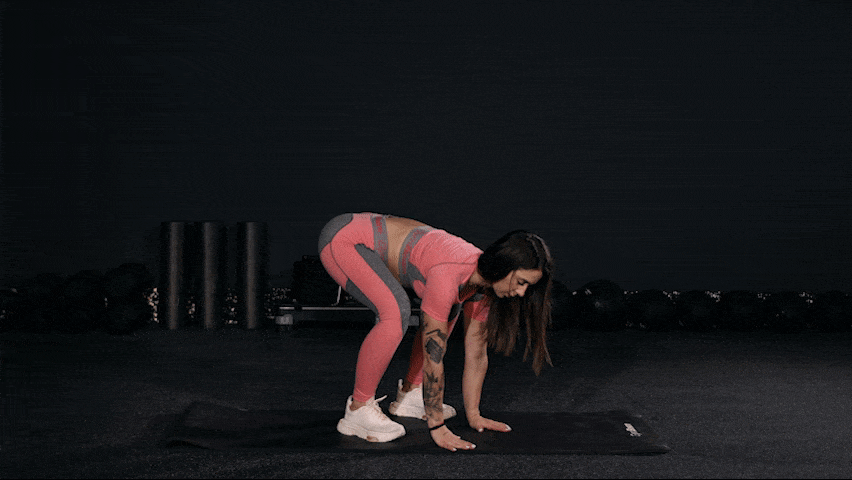
20. Pretzel Pose
- Starting position: Lie on your left side and bend your legs (approx. 90° at your knees).
- Performance: Grab your right knee (the upper one) with your left hand and pull it towards your chest. Then move your left (lower) leg towards your glutes and grab it with your right hand. Stay in this position for a few seconds and breathe naturally. Then turn to the right side and repeat the exercise.
- Common mistakes: A small range of motion.
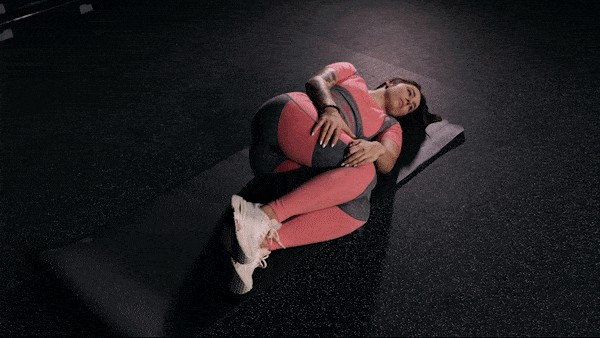
What should you remember?
There is never enough inspiration for effective back and spine relaxation exercises. You will appreciate it, for example, after a few hours of sitting at work, a long journey in a car, or when you feel like relaxing your strained muscles after training. Thanks to these exercises, you can easily create your stretching routine or combine them with the massage roller exercises. All you have to do is find a few minutes a day to take care of your back. This way you will achieve less back pain and better mobility.
Did you find this article helpful? Send it to your friends and help them relieve back pain as well.
[1] Nhs.Uk. Back pain. – https://www.nhs.uk/conditions/back-pain/
[2] Back pain: Is it stress or an injury? – https://patient.info/news-and-features/back-pain-is-it-stress-or-an-injury
[3] Prevention. 14 Daily Habits Killing Your Back. – https://www.prevention.com/health/a20430090/bad-habits-for-your-back-pain/
[4] Spine-Health. Causes of Lower Back Pain. – https://www.spine-health.com/conditions/lower-back-pain/causes-lower-back-pain
[5] National Institute of Neurological Disorders and Stroke. Low Back Pain Fact Sheet. – https://www.ninds.nih.gov/Disorders/Patient-Caregiver-Education/Fact-Sheets/Low-Back-Pain-Fact-Sheet
[6] Winchester Hospital. Lifestyle Changes to Manage Low Back Pain and Sciatica. – https://www.winchesterhospital.org/health-library/article?id=19752
[7] CSO. Implementing 10 Easy Daily Habits to Prevent and Stop Back Pain. – https://centerforspineandortho.com/news/implementing-10-easy-daily-habits-to-prevent-and-stop-back-pain/


Add a comment